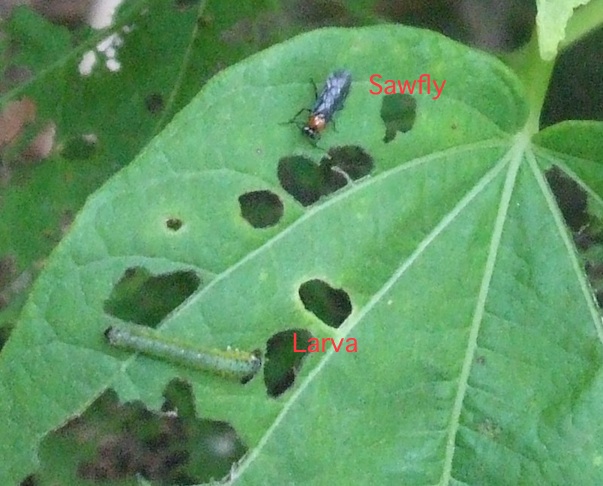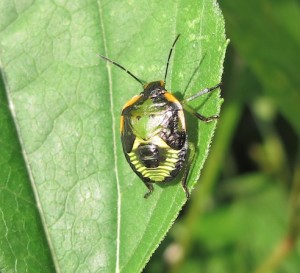
The larva of hibiscus sawfly turns hibiscus leaves into lace. © Jo Ellen Meyers Sharp
In some Hoosier gardens, hibiscus leaves look like green lace.
Don’t blame the damage on Japanese beetles. The real culprit is the hibiscus sawfly larva, which has an appetite for other members of the mallow family, including hollyhock, okra and cotton. It does not seem to bother tropical hibiscus (H. rosa sinensis) or rose of Sharon (H. syriacus)
Research on this pest began with a question from a reader. She’d already identified the problem on her ‘Lord Baltimore’, ‘Anne Arundel’ and ‘Sweet Caroline’ perennial hybrid hibiscus, and a native species (H. moscheutos). “Is there any treatment at this late date or should I just remove the plants? I am getting tired of them so removal would be no big loss,” said E.A. of Indianapolis.
That sent me to my go-to bug guy, Cliff Sadof, a professor of entomology at Purdue University Extension. Hibiscus sawflies repeatedly attack his hollyhocks, Sadof said. “They can kill a hollyhock and make hibiscus look awful,” eventually weakening the plant.

The tiny hibiscus sawfly deposits eggs inside leaf tissue. The larva emerges and devours leaf tissue, leaving only the veins. © Jo Ellen Meyers Sharp
The 3/16-inch long black hibiscus sawfly burrows eggs just under the leaf tissue. Barely visible at first, well camouflaged baby larvae hatch and begin devouring leaf tissue. By the time the green larvae reach maturity at about ½ inch long, you’ve got lacy leaves.
With a 28-day life cycle, we get four generations of the pest. That’s why it’s important to be vigilant to catch the first generation. Knocking down the first group goes a long way at controlling hibiscus sawfly the rest of the summer, he said.
The professor recommends an insecticide that contains Spinosad. To protect bees and other pollinators, “do not spray it on the flowers and be sure to hit both sides of the leaves.”
Green stink bugs show up, too

Green stink bugs lay eggs on the underside of the leaves of weeds.
Photo courtesy John Obermeyer, Purdue Extension Entomology
If my email is any indicator, another insect, the native green stink bug, also has shown up in high numbers. The native green stink bug feeds on lots of plants, including tomatoes and soybeans, as well as ornamental trees and shrubs.

Knock green stink bug nymphs from plants to help reduce the numbers of plant-eating adults. Photo courtesy Cliff Sadof, Purdue Extension Entomology
“Usually green stink bugs show up here and there, 10 to 15 at the most on a plant. But if it’s the brown marmorated stink bug, multiply that by 10,” Sadof said of the exotic pest that showed up in big numbers in 2013.
Cultural controls include removing weeds where green stink bugs hide and lay eggs. A strong spray of the hose will knock them off plants and insecticidal soap also may be effective. Always read and follow label directions.